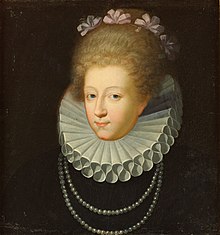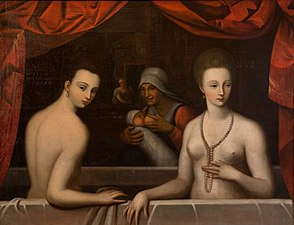Gabrielle d'Estrées
Gabrielle d'Estrées | |
|---|---|
 Portrait, 17th century | |
| Born | 1573 |
| Died | 10 April 1599 (aged 25–26) Paris, Kingdom of France |
| Spouse |
Nicolas Damerval de Liancourt
(m. 1592; ann. 1595) |
| Children |
|
| Parents | |
Gabrielle d'Estrées, Duchess of Beaufort and Verneuil, Marchioness of Monceaux[1] (French: [ɡabʁijɛl dɛstʁe]; 1573[2][3] – 10 April 1599) was a mistress, confidante and adviser of Henry IV of France. She is noted for her role in ending the religious civil wars that plagued France for more than 30 years.[4]
She persuaded Henry to renounce Protestantism in favour of Catholicism in 1593. Later she urged French Catholics to accept the
Birth
Gabrielle d'Estrées was born at either the Château de la Bourdaisière in Montlouis-sur-Loire in Touraine, or at the Château de Cœuvres in Picardy.[6] Her parents were Antoine d'Estrées, Marquis of Cœuvres, and Françoise Babou de La Bourdaisière.[7] The women in her family, particularly on her mother's side, were noted for the beauty prized in the French royal court. Her sister Diane became the mistress of Épernon and her aunt Isabelle also had the same relationship with Chancellor Philippe Hurault de Cheverny.[8]
Royal mistress
In November 1590, King Henry IV of France fell in love with Gabrielle d'Estrées.[9] She became one of his many mistresses in the middle of his bitter struggle with the Catholic League. Although he was married to Margaret of Valois, Henry and Gabrielle were openly affectionate with each other in public. Her father, anxious to save his daughter from so perilous an entanglement, married her to Nicholas d'Amerval, seigneur de Liancourt, though the union proved unhappy,[10] and was annulled by 1595.[11]
Fiercely loyal, Gabrielle accompanied Henry during his campaigns. Even when heavily pregnant, she insisted on living inside his tent near the battlefield, making sure his clothing was clean and that he ate well after a battle, handling the day-to-day correspondence while he fought. As she was intelligent and practical, Henry confided his secrets to her and followed her advice. When the two were apart, Henry frequently wrote her letters while on his sojourn trips at war camps.[12]

Born a Catholic, Gabrielle knew that the best way to conclude the religious wars was for Henry himself to become a Catholic.
On 7 June 1594, their first child was born: a son,
Henry IV also recognized and legitimized two more children he had with Gabrielle:
Gabrielle became Henry's most important diplomat, using her female friends amongst the various Catholic League families to bring about peace. In March 1596, Henry gave both Gabrielle and his sister Catherine a set of gold keys, which bestowed upon them seats on his council. This gift pleased Gabrielle so much that she took to wearing the little keys on a chain around her neck.[21]
In 1598, Henry issued the Edict of Nantes, which gave the Huguenots certain rights, while deferring to Catholics. Joining forces, the Huguenot Catherine and the Catholic Gabrielle went to work overriding the objections of powerful Catholics and Huguenots, forcing compliance with the edict. Henry was so impressed with her efforts that he wrote: "My mistress has become an orator of unequaled brilliance, so fiercely does she argue the cause of the new Edict."[citation needed]
Death and aftermath
After applying to
The King was grief-stricken,
A publication after her death called the Mémoires secrets de Gabrielle d'Estrée ("The Secret Memoirs of Gabrielle d'Estrée") is believed to have been written by one of her friends.[citation needed]
Children
Her four children with Henry were:
- Françoise de Lorraine and had issue. In 1626, he participated in a plot against Cardinal Richelieu. César was captured and held in prison for three years. In 1641 he was accused of conspiracy again and this time fled to England.
- Catherine Henriette de Bourbon (1596–1663); married Charles II, Duke of Elbeuf. Had issue
- Alexandre, Chevalier de Vendôme (1598–1629).[27]
- stillborn son* (1599).
-
César de Bourbon, Duke of Vendôme
-
Catherine Henriette de Bourbon, Légitimée de France
-
Alexandre, Chevalier de Vendôme
Representation in art
Gabrielle is the subject of the painting Gabrielle d'Estrées et une de ses sœurs by Francois Clouet, which is held in the Louvre Museum in Paris.[28] In the painting, Gabrielle sits unclothed in a bathtub in which is covered in cloth, holding what is presumed to be Henry's coronation ring given to her before their wedding and her death, whilst her sister Julienne-Hippolyte-Joséphine, Duchess of Villars,[29] also sits unclothed beside her and pinches Gabrielle’s right nipple. Henry gave Gabrielle the ring as a token of his love shortly before she died.[28]
A very similar painting with the same characters in different positions is in the Palace of Fontainebleau,[30] and yet a third one without her sister in the Musée Condé in the Château de Chantilly.[31]
J. M. W. Turner painted a watercolour of "Fair Gabrielle" at Bougival.[citation needed]
-
Gabrielle d’Estrées and Julienne-Hippolyte-Joséphine, Duchess of Villars: Palace of Fontainebleau
-
Gabrielle d'Estrées and her sister (Louvre). Gabrielle d’Estrées and the Duchess of Villars "… turn half towards the viewer as they sit in a bathtub lined with silk. The women have faces the shape of upturned petals; thin, arched eyebrows; skin the same color as the pearls they both wear in their ears. They are naked from the waist up, and both women’s small, dark eyes are locked on the viewer, mouths tight and ambiguous. But what everybody sees first—what viewers can’t help but fix their gazes on—is the hand of the woman on the left as it pinches the nipple of the woman on the right, her index finger and thumb forming a perfect "C." Above them, ruched silk curtains, heavy as thunderclouds, are parted as though the audience is at a stage’s edge. The viewer’s voyeuristic position sets the scene as a performance." -Artsy.net on the portrait.
-
Gabrielle d'Estrées au bain: Musée Condé (Château de Chantilly)
See also
- Henry IV of France's wives and mistresses
- French royal mistresses
References
- ^ French: Gabrielle d'Estrées, duchesse de Beaufort et Verneuil, marquise de Monceaux
- ^ Petit Robert dictionary, Dictionnaires Le Robert, Paris, 1988.
- ^ Desclozeaux, Adrien (1889). Gabrielle d'Estrées, marquise de Monceaux, duchesse de Beaufort (in French). Paris: H. Champion. p. 2.
- ISBN 978-1-250-14086-9.
- ^ Poisson, Georges (2013). La Grande Histoire du Louvre. Perrin. p. 465.
- ^ Desclozeaux, pp. 1-2.
- ^ Adams & Adams 2020, p. 92.
- ISBN 978-1-4214-0714-2.
- ^ Knecht, R.J. (2013). The French Civil Wars, 1562-1598. Routledge. p. 255.
- ^ One or more of the preceding sentences incorporates text from a publication now in the public domain: Chisholm, Hugh, ed. (1911). "Estrées, Gabrielle d'". Encyclopædia Britannica. Vol. 9 (11th ed.). Cambridge University Press. p. 801.
- ^ Wellman 2013, p. 322.
- ^ Wellman 2013, p. 343.
- ^ a b Wellman 2013, p. 336.
- ISBN 9780877796282.
- ^ "Gabrielle d'Estrées, Duchess of Beaufort". Britannica. Retrieved 17 April 2012.
- ISBN 978-1-000-22594-5.
- ^ "Lettres de légitimation de César de Vendôme ; Paris, 4 janvier 1595". calames.abes. [In French].
- ISBN 2-08-012062-X, 2-7084-0387-7.
- ^ Bayrou, François, Le Roi libre, Flammarion, Paris, 1994, p. 438 (French).
- ^ Bercé, Yves-Marie, 5.
- ^ Wellman 2013, p. 345.
- ISBN 9780307426536.
- ^ Bercé, Yves-Marie, 6.
- ^ Bayrou, p. 440.
- ISBN 978-1-144-90906-0.
- ^ Wellman 2013, p. 308.
- ^ Wellman 2013, p. 347.
- ^ a b Official site of the Louvre Museum - Portrait présumé de Gabrielle d'Estrées et de sa sœur la duchesse de Villars
- ^ Williams, Hannah (10 July 2019). "The Meaning behind One of the Most Oddly Erotic Paintings in Western Art". Artsy. Retrieved 5 March 2022.
- ^ "Les Dames au Bain". Château de Fontainebleau (in French). Retrieved 9 October 2020.
- ^ "Les incontournables". Domaine de Chantilly (in French). Archived from the original on 14 October 2020. Retrieved 9 October 2020.
Bibliography
- Adams, Tracy; Adams, Christine (2020). "Gabrielle d'Estrées: Never the Twain Shall Meet". The Creation of the French Royal Mistress. The University of Pennsylvania Press. pp. 85–109.
- Bayrou, François (1994). Le Roi libre. Paris: Flammarion. ISBN 2-08-066821-8(French)
- ISBN 0-333-62756-3
- Wellman, Kathleen (2013). Queens and Mistresses of Renaissance France. Yale University Press. ISBN 978-0-300-17885-2.
Further reading
- Eudes de Mézeray, François Abrégé chronologique de l'Histoire de France 3 vols. Paris: Chez Claude Robustel, 1717.
- Sully, Maximilien de Béthune, Mémoires du duc de Sully, Paris: Chez Etienne Ledoux, 1828.
- Fleischhauer, Wolfram Die Purpurlinie, Stuttgart, 1996 A semi-academic work in the form of a novel on her life (German)
- Fleischhauer, Wolfram La ligne pourpre, Paris: J.-C. Lattès, 2005.
External links
 Media related to Gabrielle d'Estrées at Wikimedia Commons
Media related to Gabrielle d'Estrées at Wikimedia Commons






